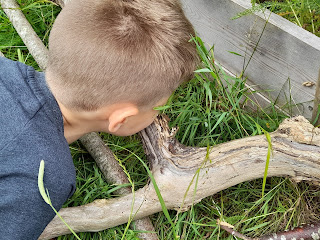Activities
The ever-present resources are for 'Bug Hunting', 'Bird exploration', and 'What's Growing'. Most sessions will also include books and basic woodwork tools, as well as a 'Nature Table', which sounds ridiculous outdoors but works well. All these are dotted around Basecamp. Adjacent to this we have a large digging area with gardening tools, plus mud kitchen equipment.
None of this is left out in Forest School, despite being on school grounds, but because our site is ours alone, we do have a storage container where we can keep these items close to the point of use.
 |
| Bug Hunting |
Let's start with the Minibeasts. We have an old bookcase as a bug hotel as well as plenty of grounds to search! I have small glass jars and magnifiers to collect the creatures in, some books about specific insects, a spotter guide, some laminated information sheets, and a book all about a Bug Hotel. This equipment differentiates itself, Year R will hunt down woodlice and use pictures to ID them. Year 6 will read the info! I have lots of identification sheets from the Wildlife Trust, RSPB, and Woodland Trust Nature Detectives. I do swap these around seasonally, partly because if they match the season they are more accurate, but partly to ensure the information looks different and presents in a different way to stop the children from ignoring it!
 |
| What's Growing |
This contains much of the same kind of resources and again is seasonal. There are cut out and laminated leaf ID pictures on metal rings, there are ID Sheets, some books, and examples gathered from nearby. We have information on lichen and mosses, fungi and wildflowers, and leaves, twigs and trees.
I spent a whole weekend in lockdown printing and laminating sheets to cover every area of learning in Forest School. The majority came from the Woodland Trust 'Tree Tools For School' site.
The Wildlife Trust has a site full of activity sheets called 'Wildlife Watch', the investigate section especially has great ID sheets.
The RSPB also has some great 'Spot It' sheets available on their website.
Sometimes info pops up randomly from elsewhere and I squirrel it away! Articles on fungi, photos of birds nests, artwork, and postcards are all scanned into the computer and printed off when needed. I hate laminating because it introduces yet more plastic to the environment, but no sheet would last longer than a day without it. I work on the premise that 1 encapsulated ID sheet equates to 1000 sheets a year in paper and photocopying ink!
The Bird 'Information Station' is the one that varies and alters the most. Again there are info sheets on feathers, eggs, and bird nests, as well as birds. There are an assortment of bird guides and some binoculars. I also have 6 toy birds that make the correct bird call - which all the children age 4 through to 11 love! When children find feathers they either keep them or add them to our basket, this time of year we are also finding eggshells, which they love to try and ID.
Their contribution makes this collection evolve all the time. The children bring quite a lot of varied knowledge about birds to Forest School. Whether it's from plucking pheasants, keeping chickens, or having bird feeders in their own gardens, and it's quick and easy to take the fact they know and help expand it.
The roofers who have spent a large portion of this year working on top of the building donated some Bird Boxes, which was very generous, and made the children excited.
Books are a must! Stories for all age groups and information... but the most popular volumes are of wildlife photography! Seeing a bee magnified and being amazed at the detail, or seeing a stoat clearly for the first time, is always popular! Books are the most moveable provision. On a picnic blanket in the sun, or close to shelter at basecamp. Sometimes it is too wet to have them out. The dampness pervades and pages end up mildewed, and muddy fingers glue pages together! The book box is something I'm not keen to put out during cold months as I like to keep them moving and warm. But a story around the campfire is never a bad idea!
Tools! For the last year, our Forest School Sessions have been shortened and included full classes. Year R through to Year 6 across 4 days. Sometimes 4 different classes in a day. It is difficult to plan and execute a proper 'making' session to include up to 30 children in what can be as little as 60 minutes!
 |
| Tool Station |













Comments
Post a Comment